White House Task Force
-
- A W O Acclaimed For Quick, Decisive Action To Combat Drought Effects Maritime Reporter, Mar 1989 #44
During last year's drought crisis, the AWO won high praise from the Secretary of Transportation for its efforts to help the barge and towing industry.
"I want to officially commend the American Waterways Operators for an outstanding job in helping to alleviate the transportation impact of the summer's record-breaking drought," wrote the Secretary.
"While most media attention was still being focused on the loss of Midwestern crops, your organization began to alert the nation to the enormous impact the drought could have on our country's transportation system. As the drought became more severe, you took the lead in organizing a highly effective joint working group between the industry, the U.S. Coast Guard and the Corps of Engineers. Finally, amidst a groundswell of demands from all sectors of the economy for drought relief, you have stood alone in refusing to turn to the federal treasury to solve your hardship," the Secretary wrote.
The story of the Drought of '88, plummeting water levels due to diminished winter snow and spring rains caused numerous tows to run aground, or be otherwise delayed, particularly on the lower Mississippi.
By June, the Coast Guard closed the Mississippi in a number of places, and nearly 2,000 barges were stranded near the confluence of the Ohio and Mississippi Rivers, despite tireless efforts by the Army Corps of Engineers to dredge out bottlenecks.
National media attention riveted on the industry's plight. All of a sudden, the low-profile barge and towing industry on the inland waterways was in an extraordinary struggle with nature, and doing so on network television.
For a brief period last summer, the Drought of '88 choked some of the key arteries of water commerce.
The Corps of Engineers worked hard. The Coast Guard worked hard. The barge industry worked hard. However, there was little coordination.
The three entities remained organized for normal operations, not the rapidly unfolding crisis.
This is the story of how this very bad situation got very much better.
On June 21, with water levels falling, AWO urged the Drought Task Force to examine using diverted water from the Great Lakes to raise the level on the Illinois Waterway and the lower Mississippi, "so that a national catastrophe can be averted," should the drought deteriorate to that crisis point. AWO received coverage on network television and in major newspapers for its proposal. Soon thereafter, AWO telegrammed its midcontinent member barge lines, requesting estimated financial losses and seeking information on operating conditions to help the Association respond to inquiries from the Executive and legislative branches, and from the media.
As the situation worsened, Assistant Secretary of the Army Robert W. Page requested that AWO staff accompany him on an aerial inspection of the most hard hit areas, to assist in formulating appropriate emergency measures, and on June 28, the White House Task Force agreed to AWO's request that the government clarify its legal authority for releasing water from the Great Lakes. The White House also asked AWO to provide it with preliminary economic impact data, with a summary of operating problems, and with other suggestions to mitigate the increasingly devastating drought.
By June 29, the Ohio River was closed at the approach to the Mississippi, as was the Mississippi River at Memphis, Greenville and Vicksburg. Groundings and blockages were occurring almost hourly, and the Coast Guard and Corps of Engineers struggled relentlessly to keep up with the effects of the rap- idly falling water. Every dredge available to the Corps of Engineers was deployed. The Coast Guard imposed limits on tows of 16 barges, and a draft restriction of 8.5 feet-—a hundred tons of cargo less than normal.
System-wide, cargo was taking more than twice its usual time.
At an emergency meeting of 45 inland barge lines in St. Louis, in a historic and unprecedented move, at AWO's urging, industry leaders elected seven of their colleagues to form the River Industry Executive Task Force (RIETF), to work with the highest levels of the Corps and Coast Guard to cut red tape, cross jurisdictional lines, and otherwise make major business policy decisions for the entire industry. They established a FAX-based industry communications network for instantaneous communications. AWO also c o n t a c t e d the Congressional Drought Task Force and provided information on the drought's impact on water transportation.
Just two days later, AWO brought together in Memphis the RIETF with the highest level Corps and Coast Guard officials. At AWO's urging, the three entities formed a joint, top-level ad hoc group to manage the effects of the drought on America's great inland river system.
Almost immediately, things began to improve vastly.
A system-wide communications network was established that provided accurate operational information to all involved. AWO's formation of the RIETF and its work to convince the government too participate in such a joint high-level policy group was a key to the success of the effort. At the same time, AWO's efforts to secure an Associated Press wire story on the formation of the RIETF helped to centralize and channel media inquiries to AWO's offices.
On July 11, AWO informed the White House about the Joint RIETF/Corps & Coast Guard Committee and designed an economic impact study. The firm of Booz-Allen Hamilton was commissioned to receive and organize the data, and AWO requested that a large sample of its membership submit fully confidential economic revenue loss information.
AWO members were immediately responsive.
AWO testified before the Senate Subcommittee on Merchant Marine on July 14, outlining preliminary economic industry losses, noting the work of the RIETF, and pressing for support of AWO's call to clear the legal decks for Great Lakes water diversion. Assistant Secretary of the Army Robert W. Page, and cochair of the White House Drought Task Force wrote AWO that "your organization's initiative to form a group of senior-level executives from the barge and towing industry to interface with federal agencies involved in drought management is on target." Similarly, Maj. Gen. Thomas A.
Sands wrote that "the group will be of much benefit to the Army Corps of Engineers and the U.S. Coast Guard ... and I particularly applaud the effort of the industry to form agroup of industry executives who will speak for the industry." Adm.
Paul A. Yost, Commandant of the USCG, wrote that "our joint industry/ government relationship will keep the rivers open throughout the summer." The Joint RIETF/Corps & Coast Guard Committee met again in St.
Louis on July 15 and successfully settled a number of major policy problems including the operation of special convoys and improvements in the system-wide electronic communications network. Soon thereafter, on July 18, a letter from the chairman of the White House Task Force assured AWO that all aspects of AWO's proposal to clear away legal obstacles to diversion of Great Lakes water to the Mississippi were being fully explored.
In a conference call with the Association's Executive Committee on July 27, AWO advised its members that the Booz-Allen Hamilton study indicated that the economic losses would be as high as $150-$200 million between June 15 and the end of September. Even so, the Association decided not to seek federal drought relief. At a heavily attended news conference in August 1, AWO revealed the economic impact information and its decision to reject fecTeral aid. AWO president Joe Farrell said at the news conference: "This is the free enterprise system, sometimes you succeed; sometimes you don't. When you don't, you shouldn't turn to the federal government to bail you out." As crisis management continued to improve, the Joint RIETF/Corps & Coast Guard Committee met again in St. Louis on September 1 and made the decision to remove mandatory navigational and operational restrictions on industry. Less than one month later, AWO received a letter from Assistant Secretary of the Army Robert W. Page noting that " ... without the intense, devoted cooperation of you and your people in bringing together a consolidated effort, I am sure we would have reached a point that there would have been a national catastrophe." On October 18, the Joint RIETF/ Corps & Coast Guard Committee met to engage in long-range planning to prepare for the spring navigation season. In that second industry summit, the industry decided to maintain the RIETF as a high-level emergency response policy group.
And on February 22, 1989, the first RIETF meeting took place in St. Louis to prepare an operations plan and coordinate industry, Corps and Coast Guard preparedness.
This year, the industry and AWO will be ready for the worst, and praying for the best.
Overall, AWO members worked in an unprecedented cooperative effort during the Drought of 1988.
Much more important than how difficult the last summer was, is the story of how successful the barge industry was in surmounting the operational and commercial obstacles brought about by the drought, and how successful the barge industry was in turning what could have been an operational and public relations disaster into a shining success.
-
 )
March 2024 - Marine Technology Reporter page: 44
)
March 2024 - Marine Technology Reporter page: 44NEW TECH OCEANOLOGY INTERNATIONAL 2024 Image courtesy Metron/Cellula Teledyne Marine acquires Valeport: Matt Quartley, MD, Valeport and Ole Søe-Pedersen, VP & Image courtesy Teledyne Marine GM Teledyne Marine announce the deal in London. Pictured (L-R): Cellula Robotics, President, Eric Jackson, Metron
-
 )
March 2024 - Marine Technology Reporter page: 36
)
March 2024 - Marine Technology Reporter page: 36LANDER LAB #10 Of special interest for marine applications, LiPo batteries are Shipping any kind of lithium battery can be a challenge, and offered in a “pouch” design, with a soft, ? at body. The pouch IATA regs vary with the batteries inside or outside an instru- is vacuum-sealed, with all voids ?
-
 )
March 2024 - Marine Technology Reporter page: 23
)
March 2024 - Marine Technology Reporter page: 23elatively inactive since 2014, the Hunga Tonga–Hunga Ha‘apai (HT-HH) submarine volcano began erupting on December 20, 2021, reaching peak intensity on January 15, 2022. This triggered tsunamis throughout the Pa- R ci? c, destroyed lives and infrastructure, and generated the largest explosion recorded
-
 )
March 2024 - Marine Technology Reporter page: 19
)
March 2024 - Marine Technology Reporter page: 19About the Author vey with the pipe tracker is not required, resulting in signi? - Svenn Magen Wigen is a Cathodic Protection and corrosion control cant cost savings, mainly related to vessel charter. expert having worked across The major advantage of using FiGS on any type of subsea engineering, design
-
 )
March 2024 - Marine Technology Reporter page: 18
)
March 2024 - Marine Technology Reporter page: 18TECH FEATURE IMR There are also weaknesses in terms of accuracy because of FiGS Operations and Bene? ts signal noise and the ability to detect small ? eld gradients. In Conventional approaches to evaluating cathodic protection this process there is a risk that possible issues like coating (CP)
-
 )
March 2024 - Marine Technology Reporter page: 16
)
March 2024 - Marine Technology Reporter page: 16TECH FEATURE IMR Image courtesy FORCE Technology OPTIMIZING CATHODIC PROTECTION SURVEY USING NON-CONTACT SENSORS By Svenn Magen Wigen, FORCE Technology he principle behind sacri? cial anodes, which are water structures, reducing the need for frequent repairs and used to safeguard underwater pipelines
-
 )
March 2024 - Marine Technology Reporter page: 15
)
March 2024 - Marine Technology Reporter page: 15sensor options for longer mission periods. About the Author For glider users working in ? sheries and conservation, Shea Quinn is the Product Line Manager the Sentinel can run several high-energy passive and active of the Slocum Glider at Teledyne Webb acoustic sensors, on-board processing, and imaging
-
 )
March 2024 - Marine Technology Reporter page: 11
)
March 2024 - Marine Technology Reporter page: 11assist in identifying mines and act as a neutralization device. About the Author Bottom mines pose even greater chal- David R. Strachan is a defense analyst and founder of lenges. Unlike contact mines, bottom Strikepod Systems, a research and strategic advisory mines utilize a range of sensors to
-
 )
March 2024 - Marine Technology Reporter page: 8
)
March 2024 - Marine Technology Reporter page: 8INSIGHTS SUBSEA DEFENSE Copyright RomanenkoAlexey/AdobeStock WHEN THE SHOOTING STOPS: BLACK SEA MINE CLEARANCE WILL FEATURE ADVANCED TECH, CONOPS By David Strachan, Senior Analyst, Strikepod Systems ince the beginning of the war in Ukraine, mine warfare mines have been the weapon of choice for both
-
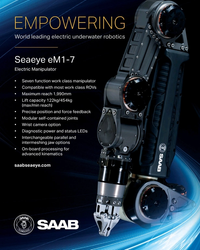 )
March 2024 - Marine Technology Reporter page: 3
)
March 2024 - Marine Technology Reporter page: 3EMPOWERING World leading electric underwater robotics Seaeye eM1-7 Electric Manipulator • Seven function work class manipulator • Compatible with most work class ROVs • Maximum reach 1,990mm • Lift capacity 122kg/454kg (max/min reach) • Precise position and force feedback • Modular self-contained
-
 )
April 2024 - Maritime Reporter and Engineering News page: 41
)
April 2024 - Maritime Reporter and Engineering News page: 41Nautel provides innovative, industry-leading solutions speci? cally designed for use in harsh maritime environments: • GMDSS/NAVTEX/NAVDAT coastal surveillance and transmission systems • Offshore NDB non-directional radio beacon systems for oil platform, support vessel & wind farm applications
-
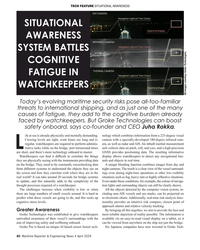 )
April 2024 - Maritime Reporter and Engineering News page: 40
)
April 2024 - Maritime Reporter and Engineering News page: 40TECH FEATURE SITUATIONAL AWARENESS SITUATIONAL AWARENESS SYSTEM BATTLES COGNITIVE FATIGUE IN WATCHKEEPERS All images courtesy Groke Technologies Today’s evolving maritime security risks pose all-too-familiar threats to international shipping, and as just one of the many causes of fatigue, they add
-
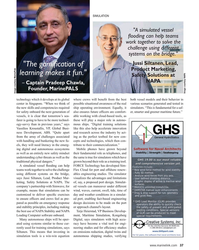 )
April 2024 - Maritime Reporter and Engineering News page: 37
)
April 2024 - Maritime Reporter and Engineering News page: 37SIMULATION "A simulated vessel ? ooding can help teams work together to solve the challenge using different systems on the bridge." – Jussi Siltanen, Lead, "The gami? cation of Product Marketing, learning makes it fun." Safety Solutions at NAPA – Captain Pradeep Chawla, Founder, MarinePALS Image
-
 )
April 2024 - Maritime Reporter and Engineering News page: 35
)
April 2024 - Maritime Reporter and Engineering News page: 35SIMULATION e have a close relationship with tech- Realism is prized beyond immersive, photo-realistic visu- nology, evidenced by, for example, als, and providers are introducing increasingly accurate func- the phones we are estimated to un- tionality. FORCE Technology’s upcoming DEN-Mark2 math- lock around
-
 )
April 2024 - Maritime Reporter and Engineering News page: 28
)
April 2024 - Maritime Reporter and Engineering News page: 28FEATURE INTERVIEW track missiles and warheads for the Mis- sile Defense Agency, and it travels with its support ship, the MV Hercules. For our Service Support ships, we have the two hospital ships, USNS Mer- cy and Comfort; two rescue and salvage ships; two submarine tenders; and the Sixth Fleet ?
-
 )
April 2024 - Maritime Reporter and Engineering News page: 27
)
April 2024 - Maritime Reporter and Engineering News page: 27RADM PHILIP SOBECK, MILITARY SEALIFT COMMAND With COVID, we had to make some hard choices for our Do your CIVMARs have upward mobility? mariners because we couldn’t rotate. Many of our mariners The Navy has Sailors who become “Mustangs,” and work found other employment, and were able to use their skills
-
 )
April 2024 - Maritime Reporter and Engineering News page: 25
)
April 2024 - Maritime Reporter and Engineering News page: 25RADM PHILIP SOBECK, MILITARY SEALIFT COMMAND Photo by Brian Suriani USN Military Sealift Command From a global supply chain perspective, What makes MSC so vital to the we’ve learned a lot about dealing with Navy’s ? eet and our military disruptions. COVID delivered a big forces around the world? wake-up
-
 )
April 2024 - Maritime Reporter and Engineering News page: 16
)
April 2024 - Maritime Reporter and Engineering News page: 16MARKETS SOVs – Analyzing Current, Future Demand Drivers By Philip Lewis, Director of Research, Intelatus © Björn Wylezich/AdobeStock t a high-level, there are three solutions to transferring Lower day rate CTVs are often used for daily transfer of technicians from shore bases to offshore wind farms
-
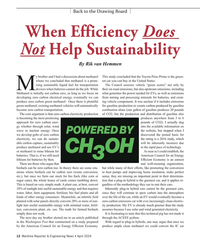 )
April 2024 - Maritime Reporter and Engineering News page: 12
)
April 2024 - Maritime Reporter and Engineering News page: 12Back to the Drawing Board When Efficiency Does Not Help Sustainability By Rik van Hemmen y brother and I had a discussion about methanol This study concluded that the Toyota Prius Prime is the green- where we concluded that methanol is a prom- est car you can buy in the United States. ising sustainable
-
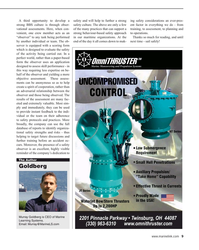 )
April 2024 - Maritime Reporter and Engineering News page: 9
)
April 2024 - Maritime Reporter and Engineering News page: 9A third opportunity to develop a safety and will help to further a strong ing safety considerations an ever-pres- strong BBS culture is through obser- safety culture. The above are only a few ent factor in everything we do - from vational assessments. Here, when con- of the many practices that can
-
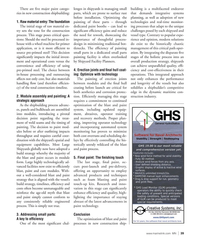 )
April 2024 - Marine News page: 39
)
April 2024 - Marine News page: 39There are ? ve major paint catego- lenges in shipyards is managing small building is a multifaceted endeavor ries in new construction shipbuilding: parts, which are prone to surface rust that demands integrative systems before installation. Optimizing the planning, as well as adoption of new 1.
-
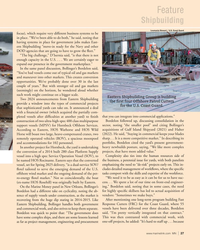 )
April 2024 - Marine News page: 27
)
April 2024 - Marine News page: 27Feature Shipbuilding Loumania Stewart / U.S. Coast Guard focus), which require very different business systems to be in place. “We’ve been able to do both,” he said, noting that having systems in place for government jobs makes East- ern Shipbuilding “move-in ready for the Navy and other DOD agencies
-
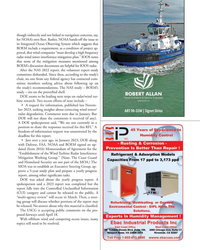 )
April 2024 - Marine News page: 25
)
April 2024 - Marine News page: 25though indirectly and not linked to navigation concerns, say, for NOAA’s own ? eet. Rather, NOAA hands-off the issue to its Integrated Ocean Observing System which suggests that BOEM include a requirement, as a condition of project ap- proval, that wind companies “must develop a high frequency radar
-
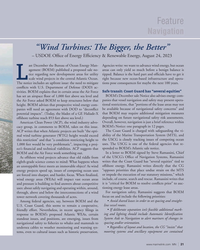 )
April 2024 - Marine News page: 21
)
April 2024 - Marine News page: 21Feature Navigation “Wind Turbines: The Bigger, the Better” – USDOE Of? ce of Energy Ef? ciency & Renewable Energy, August 24, 2023 ast December the Bureau of Ocean Energy Man- Agencies write: we want to advance wind energy, but ocean agement (BOEM) published a proposed sale no- areas can only yield so
